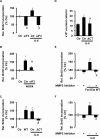NOX4 mediates activation of FoxO3a and matrix metalloproteinase-2 expression by urotensin-II
- PMID: 21965295
- PMCID: PMC3216667
- DOI: 10.1091/mbc.E10-12-0971
NOX4 mediates activation of FoxO3a and matrix metalloproteinase-2 expression by urotensin-II
Abstract
The vasoactive peptide urotensin-II (U-II) has been associated with vascular remodeling in different cardiovascular disorders. Although U-II can induce reactive oxygen species (ROS) by the NADPH oxidase NOX4 and stimulate smooth muscle cell (SMC) proliferation, the precise mechanisms linking U-II to vascular remodeling processes remain unclear. Forkhead Box O (FoxO) transcription factors have been associated with redox signaling and control of proliferation and apoptosis. We thus hypothesized that FoxOs are involved in the SMC response toward U-II and NOX4. We found that U-II and NOX4 stimulated FoxO activity and identified matrix metalloproteinase-2 (MMP2) as target gene of FoxO3a. FoxO3a activation by U-II was preceded by NOX4-dependent phosphorylation of c-Jun NH(2)-terminal kinase and 14-3-3 and decreased interaction of FoxO3a with its inhibitor 14-3-3, allowing MMP2 transcription. Functional studies in FoxO3a-depleted SMCs and in FoxO3a(-/-) mice showed that FoxO3a was important for basal and U-II-stimulated proliferation and vascular outgrowth, whereas treatment with an MMP2 inhibitor blocked these responses. Our study identified U-II and NOX4 as new activators of FoxO3a, and MMP2 as a novel target gene of FoxO3a, and showed that activation of FoxO3a by this pathway promotes vascular growth. FoxO3a may thus contribute to progression of cardiovascular diseases associated with vascular remodeling.
Figures








Similar articles
-
FOXO3a (Forkhead Transcription Factor O Subfamily Member 3a) Links Vascular Smooth Muscle Cell Apoptosis, Matrix Breakdown, Atherosclerosis, and Vascular Remodeling Through a Novel Pathway Involving MMP13 (Matrix Metalloproteinase 13).Arterioscler Thromb Vasc Biol. 2018 Mar;38(3):555-565. doi: 10.1161/ATVBAHA.117.310502. Epub 2018 Jan 11. Arterioscler Thromb Vasc Biol. 2018. PMID: 29326312 Free PMC article.
-
Mitochondrial oxidative stress in aortic stiffening with age: the role of smooth muscle cell function.Arterioscler Thromb Vasc Biol. 2012 Mar;32(3):745-55. doi: 10.1161/ATVBAHA.111.243121. Epub 2011 Dec 22. Arterioscler Thromb Vasc Biol. 2012. PMID: 22199367 Free PMC article.
-
The effects of urotensin II on migration and invasion are mediated by NADPH oxidase-derived reactive oxygen species through the c-Jun N-terminal kinase pathway in human hepatoma cells.Peptides. 2017 Feb;88:106-114. doi: 10.1016/j.peptides.2016.12.005. Epub 2016 Dec 14. Peptides. 2017. PMID: 27988353
-
Angiotensin II, NADPH oxidase, and redox signaling in the vasculature.Antioxid Redox Signal. 2013 Oct 1;19(10):1110-20. doi: 10.1089/ars.2012.4641. Epub 2012 Jun 11. Antioxid Redox Signal. 2013. PMID: 22530599 Free PMC article. Review.
-
"Sly as a FOXO": new paths with Forkhead signaling in the brain.Curr Neurovasc Res. 2007 Nov;4(4):295-302. doi: 10.2174/156720207782446306. Curr Neurovasc Res. 2007. PMID: 18045156 Free PMC article. Review.
Cited by
-
COL4A3 Mutation Induced Podocyte Apoptosis by Dysregulation of NADPH Oxidase 4 and MMP-2.Kidney Int Rep. 2023 Jun 19;8(9):1864-1874. doi: 10.1016/j.ekir.2023.06.007. eCollection 2023 Sep. Kidney Int Rep. 2023. PMID: 37705901 Free PMC article.
-
Epigenetically induced changes in nuclear textural patterns and gelatinase expression in human fibrosarcoma cells.Cell Prolif. 2013 Apr;46(2):127-36. doi: 10.1111/cpr.12021. Cell Prolif. 2013. PMID: 23510467 Free PMC article.
-
Urotensin II receptor antagonism confers vasoprotective effects in diabetes associated atherosclerosis: studies in humans and in a mouse model of diabetes.Diabetologia. 2013 May;56(5):1155-65. doi: 10.1007/s00125-013-2837-9. Epub 2013 Jan 24. Diabetologia. 2013. PMID: 23344731
-
Oxidative Stress Induces Mouse Follicular Granulosa Cells Apoptosis via JNK/FoxO1 Pathway.PLoS One. 2016 Dec 9;11(12):e0167869. doi: 10.1371/journal.pone.0167869. eCollection 2016. PLoS One. 2016. PMID: 27936150 Free PMC article.
-
Matrix metalloproteinases: inflammatory regulators of cell behaviors in vascular formation and remodeling.Mediators Inflamm. 2013;2013:928315. doi: 10.1155/2013/928315. Epub 2013 Jun 12. Mediators Inflamm. 2013. PMID: 23840100 Free PMC article. Review.
References
-
- Abid MR, Yano K, Guo S, Patel VI, Shrikhande G, Spokes KC, Ferran C, Aird WC. Forkhead transcription factors inhibit vascular smooth muscle cell proliferation and neointimal hyperplasia. J Biol Chem. 2005;280:29864–29873. - PubMed
-
- Accili D, Arden KC. FoxOs at the crossroads of cellular metabolism, differentiation, and transformation. Cell. 2004;117:421–426. - PubMed
-
- Back M, Ketelhuth DF, Agewall S. Matrix metalloproteinases in atherothrombosis. Prog Cardiovasc Dis. 2010;52:410–428. - PubMed
-
- Bonello S, Zahringer C, BelAiba RS, Djordjevic T, Hess J, Michiels C, Kietzmann T, Gorlach A. Reactive oxygen species activate the HIF-1alpha promoter via a functional NFkappaB site. Arterioscler Thromb Vasc Biol. 2007;27:755–761. - PubMed
-
- Brunet A, et al. Stress-dependent regulation of FOXO transcription factors by the SIRT1 deacetylase. Science. 2004;303:2011–2015. - PubMed
Publication types
MeSH terms
Substances
LinkOut - more resources
Full Text Sources
Molecular Biology Databases
Research Materials
Miscellaneous

